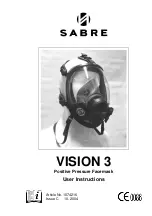
35
12-16-08
Hum and random noise
This test can be made during the check for attenuator noise. With the instrument set
on 1000 Hz, move the HL control (F3) from 0 to 60 dB and listen for low-frequency
hum (60 to 120 Hz) and random noise (hiss or low rushing sound) at all attenuator
levels. Some audible random noise at levels above 60 dB is permissible. Below 60 dB,
however, only the signal should be audible. Any of these noises can be confused
with the signal by naive subjects and affect the accuracy of the audiogram. Schedule
the audiometer for immediate service if any of the three is detected.
Distortion and frequency shift
This check can be best made by listening to the output of the AM 232 Manual
Audiometer through the earphones while presenting all 11 frequencies at a loud, but
not uncomfortable,
level (70 to 80 dB HL for normal ears.)
Listen for rattling, rasping or distortion in the tones presented. Listen also to ascer-
tain that signal frequencies change plausibly when the frequency selector (
F7
) is
moved to a new position. If distortion is heard in one earphone but not in the other,
the chances are high that the earphones are at fault and should be replaced. In any
case, the audiometer should be scheduled for immediate maintenance.
Special messages
The AM 232 Manual Audiometer performs a self-check each time the instrument is
turned on (the self-check does not occur when instrument operation resumes from the
“sleep mode”). Certain messages will be displayed on the front panel LCD if any error
in the instrument operation is detected. These messages are described below.
CAL
When a transducer or frequency is selected that has a calibration error (e.g., right
earphone at 2000 Hz), the word “CAL” will be displayed. The audiometer will not
function at this frequency with this transducer, so no invalid results can be recorded.
The word “CAL” will be displayed as long as the erroneous transducer and fre-
quency settings are selected. If the calibration error is an isolated situation, changing
either the frequency or the transducer (e.g., left earphone at 3000 Hz) will restore
normal instrument function.
As in the case with any instrument malfunction, a certified service technician should
be contacted immediately. Remember to make note of the combination of transducer
and frequency that cause the “CAL” message.




































